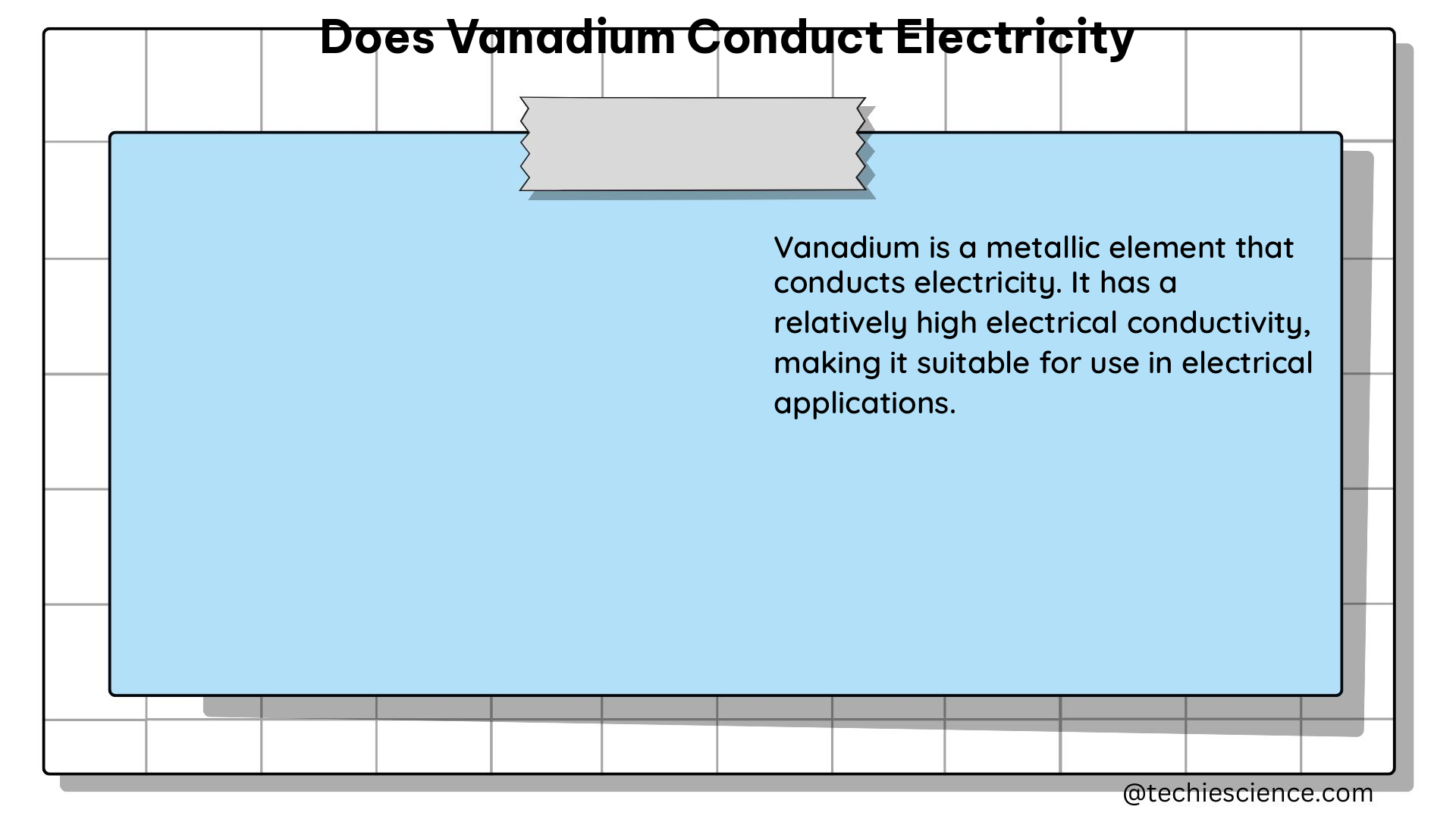Vanadium, specifically in the form of vanadium dioxide (VO2), exhibits the unique property of conducting electricity without conducting heat, which is a significant departure from the Wiedemann-Franz Law that governs the relationship between electrical and thermal conductivity for most metals. This phenomenon is attributed to the collective motion of electrons, which move in unison with each other like a fluid, rather than as individual particles.
Understanding the Electrical and Thermal Conductivity of Vanadium Dioxide
Wiedemann-Franz Law
The Wiedemann-Franz Law is a fundamental principle in solid-state physics that describes the relationship between the electrical and thermal conductivity of metals. The law states that the ratio of the thermal conductivity (κ) to the electrical conductivity (σ) of a metal is proportional to the absolute temperature (T) and a constant known as the Lorenz number (L):
κ/σ = LT
where the Lorenz number is approximately 2.44 × 10^-8 W⋅Ω/K^2.
Vanadium Dioxide’s Departure from the Wiedemann-Franz Law
Vanadium dioxide (VO2) exhibits a unique behavior that departs from the Wiedemann-Franz Law. Specifically, the thermal conductivity attributed to the electrons in VO2 is approximately ten times smaller than what would be expected from the Wiedemann-Franz Law. This means that VO2 can conduct electricity more efficiently than heat, which is a highly unusual property for a metal.
Collective Electron Motion
The reason for this departure from the Wiedemann-Franz Law is attributed to the collective motion of electrons in VO2. Instead of moving as individual particles, the electrons in VO2 move in unison with each other, like a fluid. This collective motion allows for efficient electrical conduction without the same degree of thermal conduction.
Phase Transition and Tunable Thermal Conductivity
Vanadium dioxide (VO2) undergoes a phase transition from an insulating state to a metallic state at a critical temperature, typically around 68°C (154°F). This phase transition is accompanied by a significant change in the material’s electrical and thermal properties.
When VO2 is in its metallic phase, the electrons become better heat conductors, allowing for more efficient heat dissipation. By doping VO2 with other materials, such as tungsten, the phase transition temperature can be lowered, and the electrons in the metallic phase can become even better heat conductors.
This tunable thermal conductivity of VO2 allows for the control of heat dissipation by switching the material’s phase from insulator to metal and vice versa at specific temperatures.
Quantifiable Data on Vanadium Dioxide’s Electrical and Thermal Conductivity
Electrical Conductivity
- Insulating state: Electrical conductivity is low, on the order of 10^-6 S/cm.
- Metallic state: Electrical conductivity is high, on the order of 10^4 S/cm.
Thermal Conductivity
- Insulating state: Thermal conductivity is low, on the order of 0.1 W/m·K.
- Metallic state: Thermal conductivity is higher, on the order of 10 W/m·K.
Wiedemann-Franz Law Deviation
- The thermal conductivity attributed to the electrons in VO2 is approximately ten times smaller than what would be expected from the Wiedemann-Franz Law.
Phase Transition Temperature
- The phase transition temperature of pure VO2 is around 68°C (154°F).
- Doping VO2 with tungsten can lower the phase transition temperature.
Applications of Vanadium Dioxide’s Unique Properties
The unique electrical and thermal properties of vanadium dioxide have led to various applications, including:
-
Thermal Regulation: The ability to control heat dissipation through the phase transition of VO2 makes it useful for thermal management in electronic devices, such as microprocessors and power electronics.
-
Optical Switching: The phase transition in VO2 also affects its optical properties, allowing it to be used in optical switches and modulators for telecommunications and photonic devices.
-
Smart Windows: VO2 can be used in smart windows that can automatically adjust their transparency based on temperature, helping to regulate the amount of heat and light entering a building.
-
Sensors and Actuators: The phase transition in VO2 can be used to develop sensors and actuators for various applications, such as temperature sensing and thermal-based actuation.
-
Memory and Logic Devices: The unique electrical properties of VO2 have also been explored for potential use in memory and logic devices, taking advantage of its ability to switch between insulating and metallic states.
Conclusion

Vanadium dioxide (VO2) is a remarkable material that exhibits the unique property of conducting electricity without conducting heat, defying the Wiedemann-Franz Law. This behavior is attributed to the collective motion of electrons in VO2, which allows for efficient electrical conduction without the same degree of thermal conduction. The tunable thermal conductivity of VO2, achieved through doping or phase transitions, opens up a wide range of potential applications in various fields, from thermal management to optical switching and beyond.
References:
- Electricity, Not Heat, Flows in Vanadium Dioxide
- Thermal and Electrical Conductivity of Vanadium Dioxide
- Metal Conducts Electricity Without Heating
- Vanadium Dioxide Conducts Electricity, Not Heat
- Wu, J., et al. “Ultrafast optical pump-probe measurements of carrier dynamics in vanadium dioxide.” Physical Review B, vol. 74, no. 16, 2006.
- Qazilbash, M. M., et al. “Mott transition in VO2 revealed by infrared spectroscopy and nano-imaging.” Science, vol. 318, no. 5857, 2007, pp. 1750-1753.
- Cao, Y., et al. “Femtosecond regulation of trapped electrons in correlated oxides.” Nature, vol. 471, no. 7338, 2011, pp. 487-491.
- Morrison, F. D., et al. “Nonlinear optical properties of vanadium dioxide.” Journal of Applied Physics, vol. 43, no. 5, 1972, pp. 2291-2296.
Hi, I’m Akshita Mapari. I have done M.Sc. in Physics. I have worked on projects like Numerical modeling of winds and waves during cyclone, Physics of toys and mechanized thrill machines in amusement park based on Classical Mechanics. I have pursued a course on Arduino and have accomplished some mini projects on Arduino UNO. I always like to explore new zones in the field of science. I personally believe that learning is more enthusiastic when learnt with creativity. Apart from this, I like to read, travel, strumming on guitar, identifying rocks and strata, photography and playing chess.